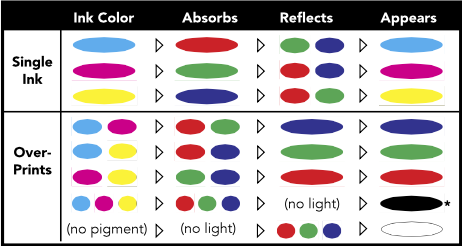Like the additive color model, subtractive color mixes wavelengths of light to produce what we perceive as color. However, the subtractive model uses pigments or ink to block – subtract – light rather than adding it.
Combining two pure additive primaries produces a subtractive primary. The subtractive primaries of cyan, magenta, and yellow are the opposing colors to red, green, and blue.
- Cyan is opposite Red
- Magenta is opposite Green
- Yellow is opposite Blue
When two subtractive primaries overlap, an additive primary is produced. When all three subtractive primaries overlap in equal quantities, all of the light is subtracted and we perceive black; the absence of light.
The Subtractive Color Model for Printing
To render color on paper, printers use reflected light and subtractive color inks. By laying Cyan, Magenta, and Yellow pigments upon a white, reflective substrate, each absorbs – or subtracts – its opposing counterpart from the white light.
- Yellow absorbs Blue, leaving Red and Green, which combine to make Yellow
- Cyan absorbs Red, leaving Green and Blue to make Cyan
- Magenta absorbs Green, leaving Red and Blue to make Magenta
A blank sheet of paper without dyes or colorants appears white because all of the wavelengths of light are reflecting off of it. Adding Cyan, Magenta, and Yellow ink absorb these wavelengths to create different colors.
- Printing Cyan + Magenta creates Blue
- Printing Cyan + Yellow creates Green
- Printing Yellow + Magenta creates Red
- Printing Cyan + Magenta + Yellow in equal quantities blocks all colors to create Black.
- As more ink is added, the color becomes darker.
This diagram shows how the subtractive primaries remove their additive counterpart from light to produce the appearance of a color.

Creating Black with the Subtractive Color Mixing Process
In subtractive color printing, a fourth color, black (K, which stands for key) is added to make four-color printing (CMYK). If we only used cyan, magenta and yellow to make black, we would get a brownish color due to impurities in those ink colors. The black ink helps neutralize images and graphics, adds density to the shadows, and saves ink.
Learn More About the Subtractive, or CMYK, Color Model
This is just a basic introduction to color models. If you’d like to learn more, check out our library of online training courses. If you're interested in learning how printers overcome the imperfections of printing with CMYK, read our Extended Gamut Printing blog for ways to print colors that are too difficult to achieve using just CMYK.
